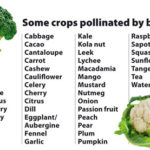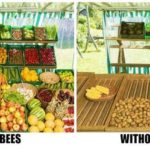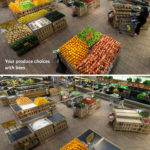EcoArt Intent – PaigeB
The World as it Could Bee
“The World as it Could Bee” would be an artistic representation of what the world would be like without the presence of bees. Bee’s are an integral part of our environment as well as the society we know and live in today. U.S. National Agricultural Statistics show a honey bee decline from about 6 million hives in 1947 to 2.4 million hives in 2008. Here is a small list of crops that would inevitably disappear without Bee’s.
- Apples
- Almonds
- Blueberries
- Cherries
- Avocados
- Cucumbers
- Onions
- Grapefruit
- Oranges
- Pumpkinds
- etc….
The purpose of this showcase would be to educate the population on the importance of honey bee’s in our society. My goal would be create a mock farm stand showing the lack of products that would be available. Ideally this mock farm stand would be located right in the center of a farmers market. This would truly allow it to stand out amongst the crowd and also gives the opportunity to educate those shopping at the farmers market of the importance of Bee’s and the produce they’re shopping for.
Budget:
Materials (ie. fake fruit, wood, paint, nails, etc) – $500
Farm Stand Slot – $300
Informational Posters – $200
Total Estimated Cost – $1,000
2 thoughts on “EcoArt Intent – PaigeB”
You must be logged in to post a comment.



Concept
1. The media used is one to many. It takes one person to create the project, and many people will see it and be influenced.
2. The strategy this project uses is to create a visual that as many people as possible will see. It is using a public space to educate people.
3. The issue this project highlights is the changing environment for bees and the vital role they play in human life.
4. I love this idea because of the issue it addresses. We all know that bees play a vital role in plant life, but we don’t tend to think about how it effects us. Seeing what will happen to our food supply without bees is a great way to visualize the problem. Because of pollution and destruction of nature, the number of bees is decreasing. I think the issue is very important and now is a good time to bring it to light.
Design:
1. The design is very straightforward and understandable. The visual of what foods will no longer exist without bees clearly shows what life will be like if we continue on this path.
2. It draws the attention of the public, and I think there would be ways to incorporate participation into the project as well. Maybe adding a description of what individuals can do to help bees could be added tothe sculpture.
Technical:
1. It doesn’t necessarily use any new technology, it is more of an art piece. If anything, it uses scientific studies that show the population of bees is decreasing.
2. The overall cost would be $1,000 for supplies. I think it would be interesting to use real fruit rather than fake fruit, since it would be better for the environment and more interactive for the audience.
Audience:
1. The intended audience is the general public. Anyone who enters a grocery store can see it.
It is geared directly towards the people walking by. Buying food is such a universal activity that it is the perfect place for the sculpture.
2. The project would challenge the audience to think about what they are relying on to survive, and to take care of those things. It would challenge them to think about what they are doing on a daily basis to not only protect something small and vulnerable like a bee, but to protect the food supply for future generations.
Creativity:
1. During your presentation you said that your neighbors are bee keepers and that inspired you. I have always been fascinated by bee keeping and my sister is looking into becoming one.
2. This is a very artistic way of showing a problem. Using sculpture as a visual representation is a great skill to have as an artist.
Concept
what media is the intent/project? 1-1, 1-many, many-many? explain
The project is 1-many. Audience see the same content, the creator has control over the content.
does the idea enlist any of the New Media Strategies? If so which & how?
It is a visual, and many people will see it.
what major issue(s) does the project engage?
Honey bee’s population has declined from 1947 to 2008.
does the concept interest you?
The concept is interesting. It will let people know the importance of honey bees.
Design
is the design clear and appropriate?
The design is clear. It is straightforward. People will know the importance of honey bee after they see the stand.
does the design invite attention and/or participation?
The design will attract attention. Because of the fake fruit, the stand is fun to look at. I think people will keep looking at the stand after they see the fake fruit. The stand will be in the middle of market, so people will see the stand. Maybe you can add some things
Technical
what tech is used? is it appropriate?
It is an art piece.
what is the cost? is it affordable for most people? the planet? is it sustainable?
The cost is $1000. People don’t have to pay anything.
Audience
who is the intended audience?
The intended audience is the public.
how is the project geared to the audience?
Anyone that enter the market will see the project.
would the project appeal to or challenge the audience? how/why?
The project would appeal to the audience because it is colorful and interesting. The fake fruit makes this project look more interesting. People like to look at unusual things. I think the fake fruit will attract people’s attention.
Creativity
does the idea stem from some personal passion of the creator?
Her neighbors are bee keepers. That’s where the idea come from.
can you detect the mark of a particular sensibility?
I would want to know the importance of bees because I am curious about animals.